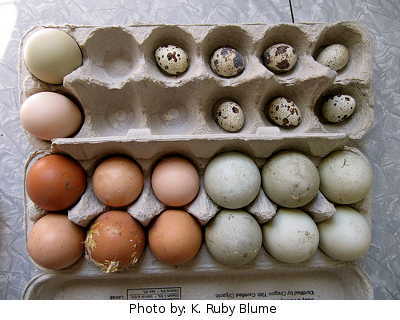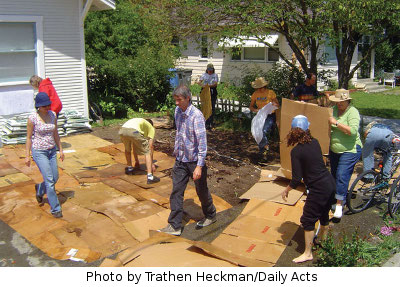
Urban homesteading vs. rural homesteading
 I
have to admit that I've been guilty of thinking of urban homesteading
as homesteading lite in the past, but Rachel Kaplan's Urban
Homesteading
helped me realize that the city version is not just a subgenre, but is
instead an endeavor with just as much potential as rural
homesteading. I was struck by the way Rachel's book introduced
all of the topics you'd expect to find in an intro to homesteading, but
took the specifics of city life into account. Below, I've listed
just a few of the ways that her advice differs from that found in rural
homsteading tomes.
I
have to admit that I've been guilty of thinking of urban homesteading
as homesteading lite in the past, but Rachel Kaplan's Urban
Homesteading
helped me realize that the city version is not just a subgenre, but is
instead an endeavor with just as much potential as rural
homesteading. I was struck by the way Rachel's book introduced
all of the topics you'd expect to find in an intro to homesteading, but
took the specifics of city life into account. Below, I've listed
just a few of the ways that her advice differs from that found in rural
homsteading tomes.
- Gardening --- In addition
to a section about how to find space to grow food in the city (which I
thought was so important it's going to make up its own post), Urban Homesteading
gives tips on making a seed ball to use in guerilla gardening and
building self-watering planters out of used materials. Espaliers
are another good choice for fitting lots of fruit trees in a city
backyard.
- Livestock --- In the
city, animals need to be small and, most of all, quiet. Compost worms, honey bees, chickens, and
rabbits are Rachel's top picks, followed by quail, ducks, and
goats. I'd never seen quail
on a top livestock list before, but Rachel explains that Japanese quail
(aka coturnix) can live in a very small space, produce eggs when less
than two months old, lay daily for at least a year, and require only
67% as much feed to produce a pound of eggs as chickens do.
- Utilizing waste --- One
of the few things I envy about city life is the amount of biomass free
for the taking. Rachel gives a recipe for making "Berkeley
compost" out of used coffee grounds, and I know from my own experience
that fallen leaves, grass clippings, and even bales of straw (leftover
from Halloween decorations) are often easy to find during trash pickup
day in the city. If you're building a structure or renovating
your existing house, discarded building supplies are also easy to come
by.
- Stocking up on food ---
In addition to all the usual advice about canning and fermenting, Urban Homesteading challenges
you to find ways to glean forgotten produce from the city. Many
people ignore the fruit that drops from their trees and will be glad
for you to come clean the apples or pears out of their yard.
- Legalities --- The downside of city living (from my point of view, at least) is the fact that you have to toe the line about number of livestock, permits, and so forth.
 With the American
population so concentrated in our cities, it's essential that we find
ways to let urbanites join in the homesteading fun. Rachel
Kaplan's book gives lots of great tips to help city dwellers head in
that direction.
With the American
population so concentrated in our cities, it's essential that we find
ways to let urbanites join in the homesteading fun. Rachel
Kaplan's book gives lots of great tips to help city dwellers head in
that direction.
| This post is part of our Urban Homesteading lunchtime series.
Read all of the entries: |
Want more in-depth information? Browse through our books.
Or explore more posts by date or by subject.
About us: Anna Hess and Mark Hamilton spent over a decade living self-sufficiently in the mountains of Virginia before moving north to start over from scratch in the foothills of Ohio. They've experimented with permaculture, no-till gardening, trailersteading, home-based microbusinesses and much more, writing about their adventures in both blogs and books.
Want to be notified when new comments are posted on this page? Click on the RSS button after you add a comment to subscribe to the comment feed, or simply check the box beside "email replies to me" while writing your comment.
